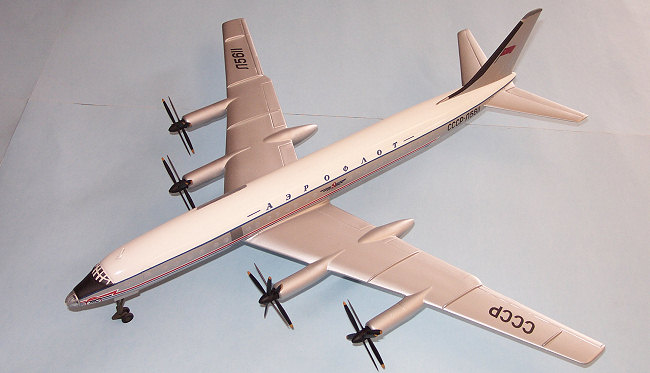
VEB/Plasticart 1/100 Tu-114
| KIT #: | ? |
| PRICE: | $more than most are willing to pay on auction sites |
| DECALS: | One options |
| REVIEWER: | Kevin Thompson |
| NOTES: | OOP East German kit. |

| HISTORY |
During the early 1950s, the United States, Great Britain and the Soviet Union all developed intercontinental long-range bombers. With the jet age in its infancy, all three nations struggled to meet the stipulated range specifications with then extant engine technology. While the United States developed the highly successful Boeing B-52 Stratofortress, British industry built a trio of aircraft known as the “V-Bombers” with the Handley-Page Victor, Vickers Valiant and Avro Vulcan. In the Soviet Union, the first jet bomber of any significance was Tupolev project 88, which became the twin-engine Tu-16. Code-named Badger by NATO, the Tu-16 was more comparable to the Boeing B-47 in size, range, speed and payload. The Soviets’ first large jet bomber was the Myasischev M-3, NATO code-name Bison. This four-engine bomber was a magnificent exercise in airframe design, but never lived up to the expected range, due to its less than efficient engines.
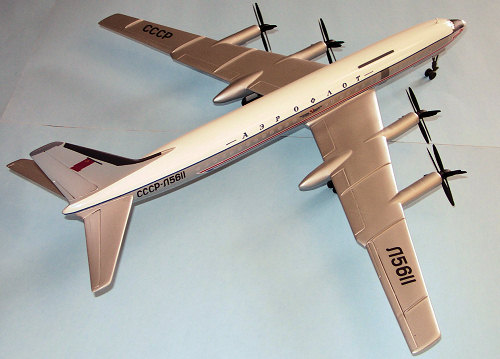 Andrei Tupolev was undoubtedly the
most prolific aircraft designer in Soviet history, and ranks among the most
significant of all time. During his life, Tupolev engineered perhaps more
different types of aircraft in larger quantity than any other aircraft designer.
Imprisoned by the Stalin regime in the late 1930s, Tupolev loyally designed
aircraft during his incarceration, including the Tu-2 twin-engine light bomber,
which ended up being one of the most effective Soviet aircraft during World War
II (what the Soviets commonly refer to as “The Great Patriotic War”). In early
1951, it was proposed that a long-range bomber could be developed utilizing
turboprop engines. Because the Soviet Union did not possess any fuel-efficient
turbojet engines, the turboprop was a viable alternative with which efficient
speeds and longer ranges could be achieved. (Ironically, the earliest design
studies for the Boeing B-52 considered turboprop engines, as well).
Andrei Tupolev was undoubtedly the
most prolific aircraft designer in Soviet history, and ranks among the most
significant of all time. During his life, Tupolev engineered perhaps more
different types of aircraft in larger quantity than any other aircraft designer.
Imprisoned by the Stalin regime in the late 1930s, Tupolev loyally designed
aircraft during his incarceration, including the Tu-2 twin-engine light bomber,
which ended up being one of the most effective Soviet aircraft during World War
II (what the Soviets commonly refer to as “The Great Patriotic War”). In early
1951, it was proposed that a long-range bomber could be developed utilizing
turboprop engines. Because the Soviet Union did not possess any fuel-efficient
turbojet engines, the turboprop was a viable alternative with which efficient
speeds and longer ranges could be achieved. (Ironically, the earliest design
studies for the Boeing B-52 considered turboprop engines, as well).
The result of four years of development was the Tu-95. Like its pure-jet contemporaries, the Bear (as it was code-named by NATO) had a high mounted swept wing of 35 degrees. Its wingspan of 50 meters (164 feet) is only a few feet shorter than that of the massive B-52. Powered by four Kuznetsov NK-12 turboprop engines of 14,750 shaft horsepower each driving two four-bladed contra-rotating propellers, the Tu-95 had a top speed of 600 mph, and a range of 8000 miles. It also has the distinction of being recognized as the world’s fastest propeller-driven aircraft. The Tu-95 and later Tu-142 versions of this bomber are, like the B-52, approaching 50 years in service, and have patrolled the skies worldwide. The Tu-95 was an engineering masterpiece, especially when one considers the state at which Soviet aircraft technology lagged behind the West during the 1950s.
As the Tu-16 Badger was later
developed into the short-to-medium range Tu-104 airliner (providing the world’s
first regularly-scheduled jet passenger service with Soviet state airline
Aeroflot), it was logical that the Tu-95 could be developed into a long-range
passenger transport. In order to accommodate the 170 to 220 passengers, a
fuselage of significantly greater diameter was designed. As was the standard of
Soviet aircraft at the time, the nose housed the navigator’s station with
windows for visual reference. The redesign changed the layout to a low-wing
configuration, necessitating a slight increase in wingspan at the wing center
section. This created a very high fuselage with the nose gear strut being some
20 feet tall. The aircraft was designated Tu-114 and was, in effect, the world’s
first “wide body” passenger aircraft, with eight-abreast seating in the
high-density layout. With a wingspan of 168 feet, a length of 177 feet, and a
maximum take-off weight of 394,621 pounds, the Tu-114 was the largest and
heaviest airliner in existence until the Boeing 747. Its massive size earned it
the prestigious nickname “Rossiya” (Russia) but the
 less-than-flattering
NATO code name Cleat. With its four engines driving 32 propeller blades
at supersonic tip speeds, the Tu-114 cruised at over 500 mph at a range of over
6,000 miles. The prototype Tu-114 (CCCP-L5611) first flew in November 1957 and
went on to establish no less than 32 records for speed, payload, altitude and
range.
less-than-flattering
NATO code name Cleat. With its four engines driving 32 propeller blades
at supersonic tip speeds, the Tu-114 cruised at over 500 mph at a range of over
6,000 miles. The prototype Tu-114 (CCCP-L5611) first flew in November 1957 and
went on to establish no less than 32 records for speed, payload, altitude and
range.
In late 1959, Soviet Premier Nikita Kruschev flew non-stop from Moscow to New York in the same aircraft for a United Nations session, and upon landing at Idlewild (now JFK), the stairways available for use with standard U.S. airliners were not high enough to reach the fuselage side doors on the Tu-114! Suitable stairs were eventually provided, but this was a bit embarrassing to the airport personnel and other U.S. officials. It was, however, a moment of pride for the Soviet crew, realizing they had the world’s largest passenger plane. Regular passenger service began with Aeroflot in 1963, and routes included Havana, Delhi, Montreal, Tokyo (in co-operation with Japan Air Lines) and Conakry/Accra. In 15 years of service, the Tu-114 proved safe and reliable, having flown over six million passengers with only one aircraft written off in an accident. In 1975, the Tu-114 was phased out of service, replaced by the Ilyushin Il-62 four-engine jetliner. In the early 1970s, nine Tu-114 airframes were converted into the Tu-126, the Soviet Union’s first AWACS aircraft. Code-named Moss by NATO, these nine aircraft served until 1984. A few surviving examples of this once-proud aircraft still exist in museums in the former Soviet Union, including the prototype, CCCP-L5611, which currently resides outdoors at the Monino facility near Moscow. A fitting testimony to the engineering genius of the legendary Andrei Tupolev, the Tu-114 combined wide body capacity, jet speed, ultra-long range and reliability some 40-plus years ago, and was the world’s largest airliner for over a decade.
| THE KIT |
East German plastic kit and toy
manufacturer Kunstoff Verarbeitung Zschopau (KVZ)
began making models of contemporary Soviet and Eastern Bloc aircraft in the
early 1960s. The initial kits were of the Tupolev Tu-104, Ilyushin Il-18, Baade
152 (a short-lived East German jet transport program), and the Tu-114. Initially
intended to be a constant 1/100 scale, their true scale varied, as did accurate
dimensional information that was supplied to the company from various sources.
As KVZ was basically a state-run toy company, it is doubtful that any of the
firm’s mold makers ever inspected and measured an actual aircraft, at least not
with these early series kits. It is my impression that, in a communist nation
during the cold war, that a “Ministry of Information” or other
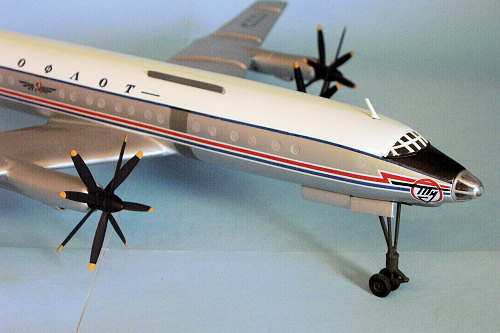 state agency
supplied maybe some half-accurate three-view drawings and some estimated
dimensions with a couple of photographs of the real thing and from these the
molds were made. As crude as Eastern Bloc industry was at the time, significant
dimensional inaccuracies and shape issues in the early kits seemed to back up
this theory. The company went on to do a full range of Soviet transport kits,
including the Antonov An-12 and An-24, Ilyushin Il-62, Tupolev Tu-134, Tu-144
(Soviet SST) and Tu-154. KVZ, later re-named Plasticart, also did some
contemporary Western airliners such as the Boeing 707, 727, Dassault Mercure,
Douglas DC-8 and Sud Aviation Carravelle. As the company progressed into the
late 1960s, the kits became more detailed and considerably more accurate. As a
complete series, KVZ/ Plasticart had amassed an impressive catalog.
state agency
supplied maybe some half-accurate three-view drawings and some estimated
dimensions with a couple of photographs of the real thing and from these the
molds were made. As crude as Eastern Bloc industry was at the time, significant
dimensional inaccuracies and shape issues in the early kits seemed to back up
this theory. The company went on to do a full range of Soviet transport kits,
including the Antonov An-12 and An-24, Ilyushin Il-62, Tupolev Tu-134, Tu-144
(Soviet SST) and Tu-154. KVZ, later re-named Plasticart, also did some
contemporary Western airliners such as the Boeing 707, 727, Dassault Mercure,
Douglas DC-8 and Sud Aviation Carravelle. As the company progressed into the
late 1960s, the kits became more detailed and considerably more accurate. As a
complete series, KVZ/ Plasticart had amassed an impressive catalog.
The Tu-114 kit, released originally
in 1963, is a classic example of Eastern Bloc kit quality of the day. The
fuselage and wings are completely devoid of any surface detail, the only
engravings being the control surfaces, canopy/windshield framing and landing
gear legs and hubs. Everything else is just smooth plastic, and the first
impression is that of a toy, with moveable ailerons, elevators and rudder. There
is a total of 152 parts, including the 60 individual fuselage side windows, each
of which must be installed separately! Wings and fuselage are excessively
warped, and fit is pretty marginal everywhere. The engine nacelles are about ½”
too long (over four scale feet), and the wingspan-to-fuselage length
relationship is way off, to the point of each wing being about 1 inch too long
(eight scale feet per wing)! Transparencies leave a lot to be desired as well.
Sounds pretty bleak so far, doesn’t it? Almost not worth building, it would
seem. However, the fuselage outline and cross section is acceptable, as are the
basic shapes of the fin, rudder and horizontal stabilizers. The landing gear
legs, tires and hubs are decent, and the basic wing
 shape is OK, except for the
double-taper leading edge. The decal sheet, basically accurate in shape and
size, has several inaccuracies with relation to color and details. The 40-plus
year old sheet is severely yellowed, and is basically unusable. I will have to
call upon my “ALPS Connection” to make this project worthwhile. This kit is
comparable to an Aurora jetliner kit of the same era, with its general
inaccuracies and toy-like quality.
shape is OK, except for the
double-taper leading edge. The decal sheet, basically accurate in shape and
size, has several inaccuracies with relation to color and details. The 40-plus
year old sheet is severely yellowed, and is basically unusable. I will have to
call upon my “ALPS Connection” to make this project worthwhile. This kit is
comparable to an Aurora jetliner kit of the same era, with its general
inaccuracies and toy-like quality.
This is where I had to make a decision. I had two choices. I can either scrap this project right now and go on to that Tamiya 1/48 Dinah, or lower my expectations of this kit and make it into a nice “travel agency-quality desk model”. Okay, let’s look at some of the positives. First of all, I think that the Tu-114 is a really beautiful and interesting aircraft. Second, this is the only kit of the Tu-114 (besides a Welsh Models 1/144 vacu-form, and that would be an even greater effort to complete). Third, with the application of some effort and a nice set of decals, this could be made into a nice “travel agency-quality desk model”. Understanding the limitations of what I’ve got to work with, and realizing my expectations of the finished product to be attractive and colorful but relatively simple and not entirely accurate, I decided to get started.
| CONSTRUCTION |
As with any model of a tricycle-gear
aircraft, nose weight was installed for proper sitting. Using lead automotive
tire “tape weights”, I used about two ounces worth as ballast, gluing an ounce
in each lower side of the forward fuselage. The next step was to install the
windows, which install from the inside of each fuselage half. Ultimately these
would only serve to fill the holes in the fuselage sides. I will elaborate more
on that later. Because there is no internal detail, the fuselage halves were
painted flat gunship gray on the insides to create a shadow effect. The fuselage
halves were then cemented together and held tight with several rubber bands and
clamps to overcome their warped nature. The rudder was cemented to the fin in
the straight-ahead position. The 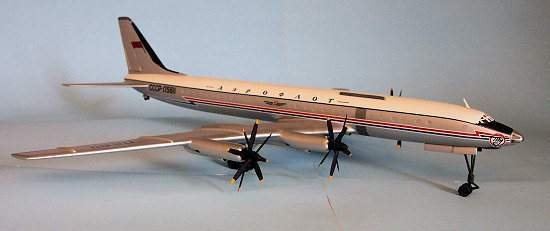 radome, located as a bulge on the lower forward
fuselage, was cemented in place, as well as a central duct near the wing root.
The horizontal stabilizers and elevators were cemented in place and true-sighted
before they dried.
radome, located as a bulge on the lower forward
fuselage, was cemented in place, as well as a central duct near the wing root.
The horizontal stabilizers and elevators were cemented in place and true-sighted
before they dried.
After the fuselage construction was basically finished, it was time to do the wings and engine nacelles. When I first dry-fitted the basic airframe together, I could see that the wingspan was significantly oversize for the fuselage length. Although the basic fuselage outline was acceptable, it was time to do some research on the actual dimensions. The kit instructions, written over 40 years ago in German and Russian, list the fuselage length as 47.2 meters, and the span at a whopping 57 meters. The truth of the matter is that the actual aircraft is 54.1 meters long with a wingspan of 51.4 meters. These dimensional discrepancies explain a lot of things. As I mentioned earlier, actual aircraft were probably not measured in the making of these kits, and the information available proved to be inaccurate. Measuring the kit fuselage out at 47.2 centimeters would have been correct in 1/100 scale if the original dimensions were correct. Having more up-to-date and correct dimensional information available means that the fuselage is really 1/115th scale. This being the case, the wingspan comes out to 1/90th scale! The remaining modifications to the wings will have to be adjusted “down” to 1/115th instead of 1/100th scale. Ultimately, this will be a compromise, as it will not be possible to make the wings exactly scale with the fuselage, without completely discarding the wings and starting from scratch. Remembering my goal of producing an acceptable and improved model from something quite inaccurate, it would be possible to get the dimensional relationship to about 95% accuracy by changing a few things.
So I took the wings and cut
approximately 1½ inches (38 mm) from each wingtip. Likewise, the same amount of
material was removed from each aileron. The main reason for retaining the wings
and getting them “as close as possible” is due to the factors of chord, taper,
airfoil thickness and wing fence spacing. Once I had the wings cut and cemented
together, it was time to look at
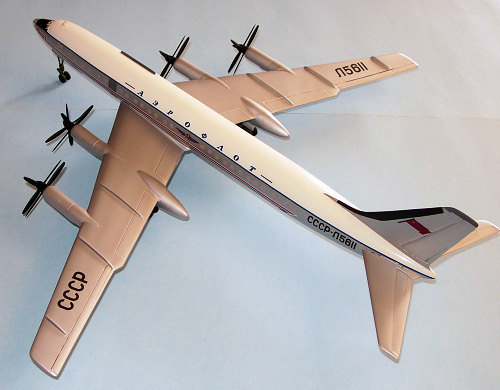 the kit’s other major inaccuracy: engine
nacelle length. The nacelles in this kit consist of three pieces for each
engine. There are two cylindrical halves and one end-cowling piece (where the
propellers go) per engine. The fit of these parts is simply awful, as the
diameters are different, and the bases not true and “square”. Each pair of
cylindrical nacelles were cemented together then shortened by ½ inch. Then the
end-cowlings were cemented to the cylindrical halves, as true, square and
concentric as possible. These were then cemented to the wings.
the kit’s other major inaccuracy: engine
nacelle length. The nacelles in this kit consist of three pieces for each
engine. There are two cylindrical halves and one end-cowling piece (where the
propellers go) per engine. The fit of these parts is simply awful, as the
diameters are different, and the bases not true and “square”. Each pair of
cylindrical nacelles were cemented together then shortened by ½ inch. Then the
end-cowlings were cemented to the cylindrical halves, as true, square and
concentric as possible. These were then cemented to the wings.
I went through a lot of sandpaper and Squadron White Putty to get this airframe completed. The fuselage was extensively sanded to get out some major irregularities in the surface and to smooth over the fuselage side windows, as decals would eventually be used to replicate these. The wings and nacelles also required major sanding and filling, followed up by wet sanding using 400-grit. Once these sub-assemblies were sanded and filled, the wings were then cemented to the fuselage. Most Tupolev swept-wing designs had slight anhedral, but the kit’s fit at the wing root was poor and inconsistent side-to-side. Some more sanding and adjusting finally got a decent wing root fit. Once the wing roots dried, more sanding, filling and wet sanding followed. After the basic airframe was completed, several coats of flat gray were applied as a primer, then wet sanded with 600-grit. A couple of pieces that would have gotten in the way or broken off during sanding were installed, including the blade-type antenna atop the forward fuselage, and air intake ducts beneath each engine nacelle. Now that the major construction and modifications were out of the way, it was time to paint the model.
| COLORS & MARKINGS |
Circa 1959, the prototype Tu-114, CCCP-L5611 carried an early Aeroflot paint scheme of a white fuselage cap above the fuselage side windows with the remainder in natural metal. A very striking and attractive red, white and blue “lightning bolt” stripe adorned each fuselage side beneath the side windows, stretching from the nose of the aircraft to beneath the horizontal stabilizers. The Tupolev OKB logo is proudly displayed at the forward fuselage, at the front end of each stripe. Later Aeroflot schemes more closely resembled western airline liveries, with the majority of the fuselage in white, and a lot of blue trim. The early scheme, which is what the kit decals are based on, best accents the shape of the aircraft and is in my opinion more elegant.
The entire airframe was sprayed with
several coats of Testors Model Master insignia white (gloss) and allowed to dry
for approximately one full week before handling. After the white had dried
sufficiently, the nose anti-glare panel and vertical fin area were painted flat
black. Atop the vertical fin is a horizontal panel that is gunship gray. I have
some color photos of this actual aircraft taken by the Soviet crew during its
New York stay, which have proved extremely valuable in the areas of colors and
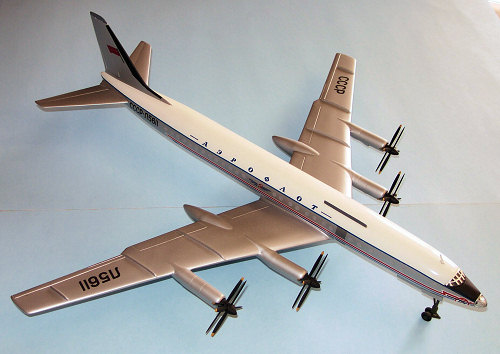 markings. The next step was to mask off the white section (and the other
panels), and shoot the entire airframe with Testors non-buffing aluminum
metalizer. The real aircraft was not shiny or polished, so the dull look of the
non-buffing aluminum was the most accurate choice. It took at least two complete
bottles of the aluminum to get really thorough coverage on a subject as large as
this. Once it had dried completely, it was time to give this big bird its
elegant livery.
markings. The next step was to mask off the white section (and the other
panels), and shoot the entire airframe with Testors non-buffing aluminum
metalizer. The real aircraft was not shiny or polished, so the dull look of the
non-buffing aluminum was the most accurate choice. It took at least two complete
bottles of the aluminum to get really thorough coverage on a subject as large as
this. Once it had dried completely, it was time to give this big bird its
elegant livery.
As previously stated, the kit decal sheet could be used as a pattern, but had several significant errors that needed correcting. Calling upon Mr. Mark Borer, who is an airline pilot and part-time decal maker, I sent him the original sheet with all the desired changes outlined on the sheet. The TU-114 prototype is in Aeroflot livery trimmed in red, white and blue striping (remember that Russia also uses these three colors). The kit got the red and blue mixed up, so the stripes were bass-ackwards, and the demarcation line for the white cap was red when it was supposed to be blue. The Aerflot signage is in blue, and the registration numbers are black. The Soviet flags on the original sheet also needed alteration. What Mark sent me back was nothing short of sensational; an absolutely beautiful ALPS-generated set of corrected markings. It is, in my opinion, the markings that really make this model attractive. Often the correct markings can help even the most inaccurate model to look somewhat realistic and attractive. The decals worked very well, and Mark even supplied circular side windows in a medium gray as per my request. On the actual aircraft, the outer fuselage immediately opposite the inboard propellers was reinforced with steel plate. It was originally stated that this was to protect the fuselage from ice slung from the inboard props, but it is possible that they were installed for an extra margin of safety should a prop malfunction occur. In any case, the steel-reinforced areas on the fuselage are significantly darker than the aluminum areas, so I took some spare decal film sprayed with steel metalizer, cut them to shape and size and applied them to the fuselage sides. Once all the decals had dried, it was time to put the finishing touches on the model.
| FINAL CONSTRUCTION |
Landing gear legs and wheel hubs are
painted dark green, as with most Soviet aircraft. Once the tires were painted
black, the landing gear assemblies were installed. Tu-114 also has small twin
tail wheels, possibly to aid in over-rotation on take-off.
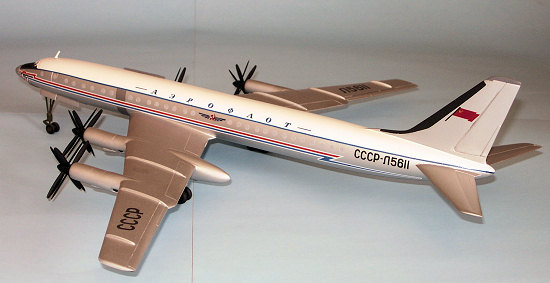 Propeller blades and
spinners are black with yellow tips on the prototype, but later aircraft had
variations on this. The propellers were then inserted into the nacelles with no
retainer caps, as it would have been necessary to install the props before
nacelles went on the wings. This would have complicated the entire assembly
process, and I almost always try to have props that spin freely on the completed
model. Landing gear doors were painted aluminum, and installed. Note the two
different angles of the open nose gear doors. The kit exhaust stubs are totally
inaccurate, so these were omitted and the exhausts were represented with just a
dab of flat black paint. The cockpit windshield framing was painted white, and
the navigator’s nose glazing is framed in aluminum. The latter is not quite
correct in shape, but this was overlooked for simplicity. The upper fuselage
blade antenna is painted in semi-gloss gray, as is the lower radome bulge, and
the forward mast in gloss white. With those last items in place, the kit is
completed.
Propeller blades and
spinners are black with yellow tips on the prototype, but later aircraft had
variations on this. The propellers were then inserted into the nacelles with no
retainer caps, as it would have been necessary to install the props before
nacelles went on the wings. This would have complicated the entire assembly
process, and I almost always try to have props that spin freely on the completed
model. Landing gear doors were painted aluminum, and installed. Note the two
different angles of the open nose gear doors. The kit exhaust stubs are totally
inaccurate, so these were omitted and the exhausts were represented with just a
dab of flat black paint. The cockpit windshield framing was painted white, and
the navigator’s nose glazing is framed in aluminum. The latter is not quite
correct in shape, but this was overlooked for simplicity. The upper fuselage
blade antenna is painted in semi-gloss gray, as is the lower radome bulge, and
the forward mast in gloss white. With those last items in place, the kit is
completed.
| CONCLUSIONS |
This kit was very rewarding to build. Yes, it needed major modifications and is still not completely accurate, but the finished product is, in my opinion, attractive and gives a reasonable representation of the actual aircraft. A big “Thank You” goes out to Mark Borer for the decals; these are what really made the model. Perhaps some day a better kit of this historic aircraft (besides the vacu-forms that have already been done) will be produced, but it is a very “special interest” subject and would probably not be a big seller. As an airliner version of the great “Bear” bomber, a fitting nickname for this plane would be the “Bearliner”. It is a testimony to Soviet industry some 50 years ago.
| REFERENCES |
The Osprey Encyclopedia of Russian Aircraft by Bill Gunston, Osprey Publishing
Vintage Russian Props and Jets of the Iron Curtain by Colin Ballantine, MBI Publishing
Airliners.net and personal photo collection.
March 2007
Copyright ModelingMadness.Com. All rights reserved. No reproduction without express permission.
If you would like your product reviewed fairly and fairly quickly, please contact the editor or see other details in the Note to Contributors.